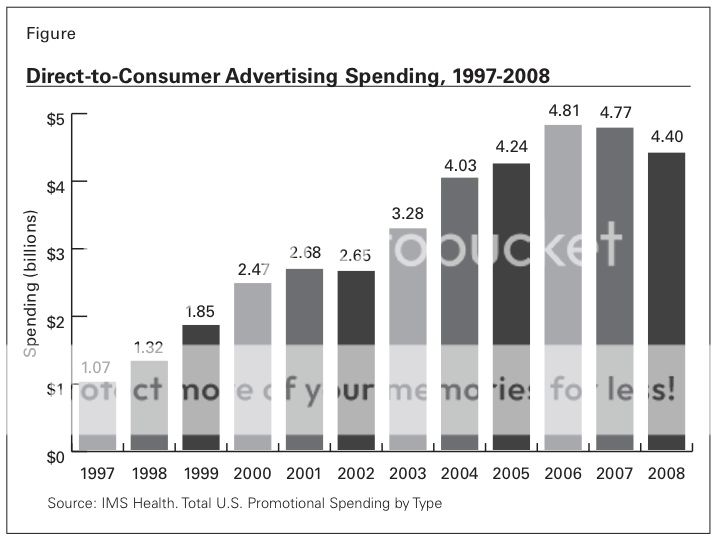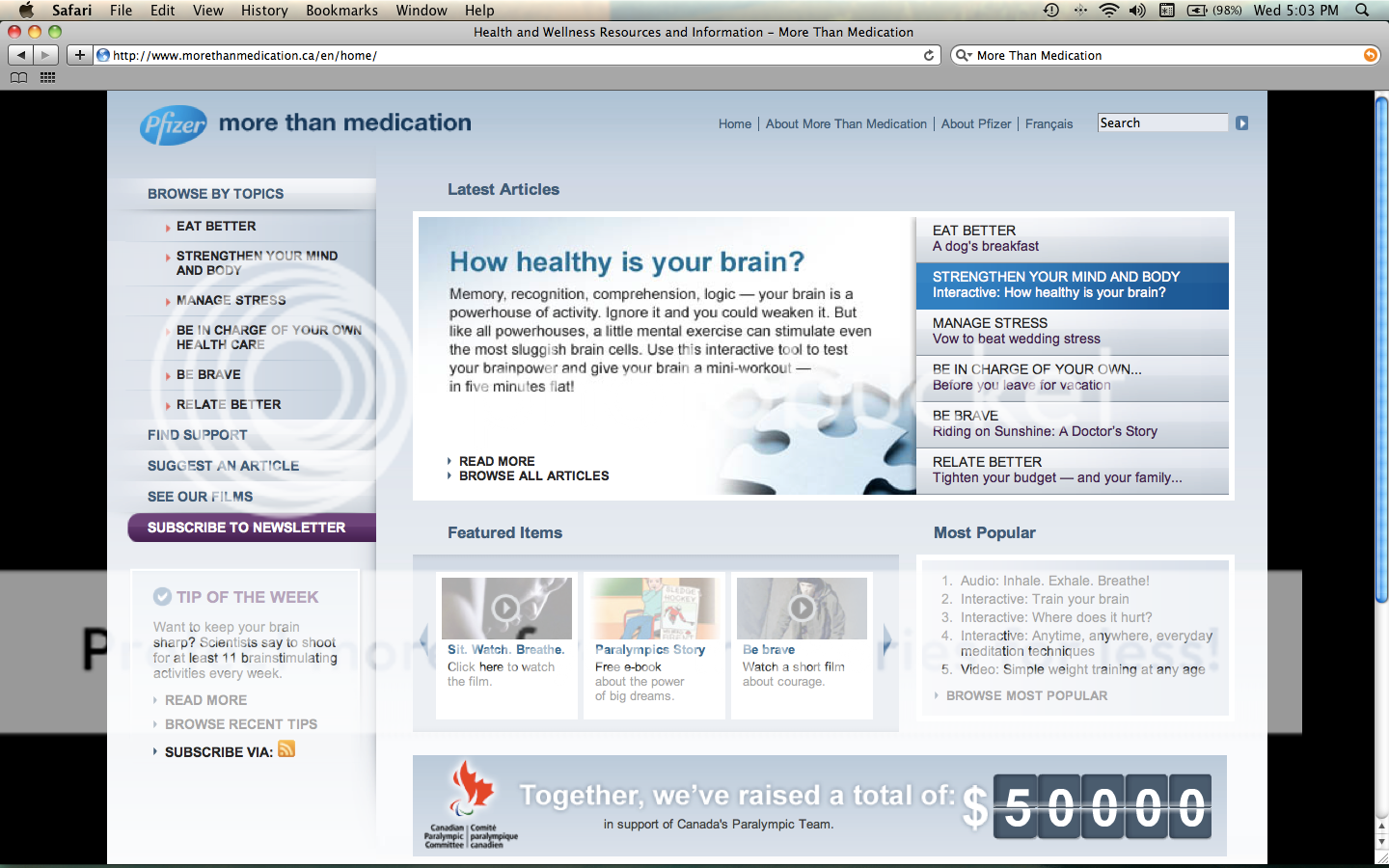Selling Science Smartly: Pfizer’s “More Than Medication” Campaign
Sep2

“Ask your doctor if this hard-to-pronounce medication is right for you.” Sound familiar? It should. Over the last decade, it’s become difficult to watch an hour of television or read a magazine without running into a commercial for the latest cure for (insert disease here). For all of their ubiquity, the majority of ads are shockingly bereft of uniqueness. Bland, boring, and banal, they represent some of the worst of science creative in modern media. Here at ScriptPhD.com, we couldn’t think of a more appropriate category for the next installment of our ongoing advertising series “Selling Science Smartly.” Rather than expound on the plethora of bad pharmaceutical ads, we deconstruct a near-perfect Pfizer campaign out of Canada and interview the executive creative director behind the concept. Read our complete article under the “continue reading” cut.
Campaign: Pfizer “More Than Medication” (television, web)
Agency: Crispin Porter + Bogusky (formerly Zig Toronto)
Industry: Pharmaceuticals
1999 was a seminal year in the long history of direct-to-consumer marketing of drugs and pharmaceutical products. No, this was not the year that they debuted. In fact, the selling of chemicals and potions goes back to the early 1900s, when deceptive patient ads (snake oil remedies) made up to 50% of advertising revenue for newspapers. Significant changes didn’t occur until 1938, when Congress passed the Federal Food, Drug & Cosmetic Act that stipulated, among other things, that a drug had to be proven safe and effective before it could be marketed. In the early 1980s, when marketing of drugs spilled over from medical professionals to consumers, the FDA requested a brief moratorium on televised ads, which it lifted two years later, requiring only that the ads include a brief summary of the drug’s side effects, contraindications, warnings, and precautions, and provide “fair balance” between the drug’s risks and benefits (see terrific review). It wasn’t until 1999 that the FDA greatly loosened these requirements, only asking that advertisers provide information about side effects in the audiovisual presentation. The rest, as they say, is history.

Direct-to-consumer advertising spending, 1997-2008.
The result of this deregulation of oversight has been an outright torrent of television and print ads over the last decade peddling panacea for everything from depression to restless legs. The table above shows the steady rise in overall spending on direct-to-consumer marketing since the FDA amendment. While the recent recession has somewhat tempered spending, the sector has not suffered to the degree that others have. And while it is true that ad agencies have to contend with much more stringent FDA guidelines for required content (such as warnings, side effects, and medicinal purpose) for drugs than for almost any other product—a unique, difficult creative obstacle—the fact is, pharmaceutical ads are many, and many aren’t good.

A 2001 print advertisement for the HIV cocktail medication Zerit that garnered harsh criticism.
Remember that R.E.M. song “Shiny, Happy People?” It could be the anthem of the majority of pharmaceutical ads. You may not know what this medication is for, but it will make you smile as you run in slow motion through fields of sunflowers (assuming that you don’t have allergies; there’s a different commercial for that). Why not ask your doctor about it?? Take for example the egregious, bordering on offensive, 2001 print ad in the picture on the right for the HIV cocktail Zerit. A handsome, chiseled, smiling model in the foreground offers palliative assurance for a disease that scientists have found no cure for, while a group of background “patients” climb a symbolic mountain. The ad was roundly excoriated as the “Joe Camel of drug ads,” and even contributing to an epidemic of unsafe sex by making false promises and misleading impressions. (Actual side effects of HIV cocktail therapy can be so painful and debilitating that some patients refuse treatment.) According to an article in the trade magazine Advertising Age, just last year, the FDA admonished a group of 14 leading pharmaceutical companies for what it claims are misleading, misbranded ads on search engines such as Yahoo! and Google. Some wonder outright whether the proliferation of pharmaceutical marketing, now seen equally as a luxury for the healthy as a necessity for the sick, is having a deleterious effect on medicine.
It is within this cluttered field of profligate, if trite, advertising that an exceptional, authentic campaign out of Canada caught our eye. Geared towards encouraging personal health and wellness, the “More Than Medication” campaign for Pfizer by the Toronto office of ad agency Crispin Porter + Bogusky includes a series of well-produced, well-written television ads (mini-films, really) and a informative website. The storytelling within the two films, “Graffiti” and “Breathe,” is a particular highlight. We dare you to watch the first video, “Graffiti,” all the way through without crying.
Why it’s good science advertising:
The cleverness of CP+B’s “More Than Medication” campaign is 50% in the content that’s there, and 50% in the content that isn’t. Missing are the saccharine smiles, ridiculous athletic feats and idyllic dalliances of perfectly healthy people that never took the medication they’re purporting to be endorsing. Rather than portraying people who could be anyone (or, sadly, no one), these ads are the antithesis. “More Than Medication” is about life—mundane, radiant, lifechanging, heartbreaking. Through all of these milestones, Pfizer is attempting to build relationships one person at a time, and be a valuable presence in their healthy lives at their most important stages. Only time will tell if the campaign pays dividends, but as advertising strategy, it’s brilliant. Pharmaceutical companies rely on wholescale batch assembly at every stage of development, from searching for molecules as drug candidates, to researching them, to the mass production thereof. In fact, the fermentation tanks developed by Pfizer that enabled the first-ever mass production of penicillin during World War II became a national historic landmark in 2008. This doesn’t dictate that pharmaceutical ads must follow the same standard operating protocol.
Why it works:
Beyond “reinventing” pharmaceutical advertising, the “More Than Medication” campaign taps into an important (and growing) wellness zeitgeist being embraced by the professional and private health care sectors. Within the last few years, emphasis has shifted significantly from medication to meditation, pills to pilates, and technology to tofu. Individual preventitive care, including eating habits, exercise, healthfulness beyond chemicals, and individual responsibility, has been gaining momentum as a critical component of modern medicine, nowhere more than in how it is advertised. Kaiser Permanente’s enormously successful and popular “Thrive” campaign, recently expanded to the tune of $53 million, has echoes the welness call to arms of Canada’s “More Than Medication” spots. Internal documents indicate that the 2004 campaign was launched to combat a declining membership of 150,000 in a similarly reviled industry (health insurance). The initially modest reach has since expanded to print, outdoors, television and radio.

The home page of the "More Than Medication" website.
Pfizer supplemented their television spots with an interactive website that offers resources for individuals and their families, including eating better, strengthening mind and body, practical life tips, and places to find help to achieve these goals. In doing do, the pharmaceutical behemoth rebrands themselves as in touch, personally connected on an individual level and convey that they care about their patients’ health even if it means never having to take one of their medications.
What other science campaigns can learn from this one…
In Selling Science Smartly, don’t be afraid to be emotional. It seems like contradictory advice. Science and medicine are precise, technical and exacting, and needfully so. What they are not is antiseptic. Ask the medical doctor and nursing staff that spend days, weeks and months getting to know patients and integrated into their lives. Ask the patients and families who experience some of the most emotionally-charged moments of those lives (both joyous and sorrowful) in a hospital. Ask the scientist that slaves away at the bench in the hope that his or her efforts might save or improve lives. How do I know this last one? Because I was one of them. I did a large chunk of my PhD graduate thesis in a Novartis not-for-profit research institute doing drug discovery. My experiments led to a target candidate for acute myeloid leukemia (largely affecting young patients) which is currently being tested in mice. The exultation of a successful experiment and reward of hard work was far supplanted by pure elation at the thought that a life saved far in the future was because of my contribution. There is emotion in science and medicine; indeed, there can be no precision without passion. The role of a good creative is to extrapolate and harness it effectively. To all of my colleagues in labs and hospitals across the world and to all of the patients that their work ultimately affects, a campaign such as “More Than Medication” is a fitting tribute.
Questions for Aaron Starkman, Executive Creative Director—“More Than Medication” campaign for Pfizer
ScriptPhD.com: What was the client’s primary objective with this campaign and how did it lead to the development of the “More Than Medication” concept?
Aaron Starkman: The client wanted to create a bond of trust with consumers. Research showed that consumers don’t trust drug companies, and believe that they put profits before people. In Canada, we also have health care system issues with limited physician access and pressure on doctors to spend less time with patients. Canadians feel powerless when it comes to their health.
We knew that in order for Pfizer to build trust, we had to show Canadians that Pfizer’s point of view was different from other pharmaceutical companies; that, as a company, they believe that wellness is not achieved by taking pills, but about a more holistic, balanced approach that doesn’t require any of their drugs at all. “More Than Medication” was the freshest and clearest expression of our core idea. It takes a lot of people by surprise that a pharma company would take such a stance.
SPhD: Big pharma can be publicly perceived as a bottom line, profit-driven pill dispenser. Additionally, people’s eyes tend to glaze over when dealing with any scientific or medicinal concepts. How did these dual challenges figure in the ultimate mapping out of the “More Than Medication” campaign?
AS: We couldn’t let the work we did reinforce any of the negative perceptions of the pharma industry. We took the completely opposite tack to traditional pharma campaigns which typically focus on research and innovation and how that benefits people. Ultimately, those messages don’t resonate because they are company focused, not people focused. To break through, Pfizer had to shed all of the baggage and aim for a more insightful, emotional high ground which no other pharma company has done, even to this day.
SPhD: The “Be Brave” and “Breathe” videos for this campaign have a tremendously cinematical composition and emotional resonance, above and beyond the feel of a typical :30 or 1:00 ad. Can you speak to the creative development of these “mini-movies”?
AS: Internally, we refer to them as films. And that’s how our director John Mastromonaco treated them. John is a brilliant director and he’s really amazing at developing characters quickly. In “Be Brave” viewers go from feeling that the main character is a thug, to empathizing with him, to getting to know his family, to realizing he’s an amazing brother and a good person- that’s a lot. But John and his production company Untitled Films really believed in the project and the message Pfizer wanted to convey. And they were amazing partners throughout both projects.
SPhD: The ad campaign was launched in 2008. What has been the tangible impact to Pfizer and across Canada?
“More than medication” is more than a campaign – it’s a mantra that has positively impacted how Pfizer behaves as an organization. It’s been culture shifting for them. Externally, it has raised brand scores across a variety of metrics, trust being one of them.
SPhD: Biggest piece of advice for tackling an unorthodox campaign in a technical or dry field (in this case biotech/pharma)?
AS: Be brave.
SPhD: What’s a current ad campaign or creative concept that you really like and why?
AS: I love a non-traditional campaign from Sweden for Swedish Postal Service. They created their own celebrity called ‘Stefan the Swopper’. This guy became famous because he used social media to get out his message. And his message was that he wants to trade every single thing he owns – from his car right down to his toothbrush and boxer shorts. When people asked for details on how the swapping can work, Swedish Post’s service was revealed by Stefan. The campaign was an unbelievable success and a revolutionary way for a client to launch a service.
Take a look at this short video chronicling the clever ‘Stefan the Swopper’ viral campaign construction and its effects in marketing the Postal Service in Sweden:
ScriptPhD.com gratefully thanks Stephen Sapka and Aaron Starkman from Crispin, Porter + Bogusky for their time, coordination and enthusiasm for this project.
~*ScriptPhD*~
*****************
ScriptPhD.com covers science and technology in entertainment, media and advertising. Hire our consulting company for creative content development.
Follow us on Twitter and our Facebook fan page. Subscribe to free email notifications of new posts on our home page.

















